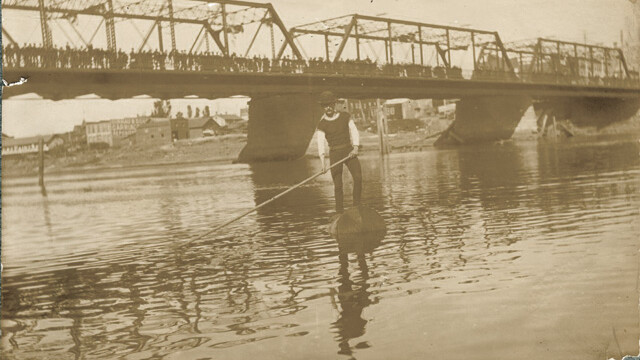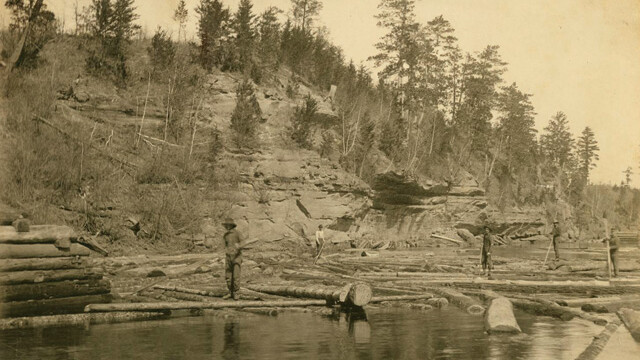Resurfacing with the Truth
B.J. Hollars recreates (and fabricates) tales of death on the Valley’s waterways

“It was a small town by a small river and a small lake in a small northern part of a Midwest state. There wasn’t so much wilderness around you couldn’t see the town. But on the other hand there wasn’t so much town you couldn’t see and feel and touch and smell the wilderness.” –Ray Bradbury’s The Halloween Tree
Not a year goes by that I don’t read Ray Bradbury’s The Halloween Tree, the story of a pack of children who head out one Halloween night to rescue their friend Pip from evil forces. To save him, they must first endure a whirlwind tour to better understand the holiday’s beginnings – from ancient Egypt, to the Romans, to the Celts. At book’s end, when confronted with Moundshroud, the skeletal-headed manifestation of Death himself, the children are faced with a terrible choice: Are they willing to give up a year at the end of their lives in order to save their beloved friend?
It’s the kind of moral crisis that’s perfect for big-hearted Midwesterners such as us. We aim to please – always at the ready to offer a helping hand – but just how much more of ourselves are we willing to give?
Beyond Bradbury’s fantastical world, none of us will ever face such a curious choice. But it’s a question worth mulling: What might we do to bring someone back?
Of course, there’s no bringing anyone back; though through literature, we might at least allow the memory of the departed to resurface. Which is what I’ve tried to do by researching historical drownings from this region, retelling the tales of people who lost their lives in our own small rivers and our own small lakes in our own northern part of a Midwest state.
Here in Eau Claire – much like in Bradbury’s fictional town – the wilderness surrounds us while we, too, surround the wilderness. It’s this borderland, this fringe between wild and tame, that has given and cost us so much. The rivers built this town, and in conjunction with the trees, blessed us with a lumber industry. But the rivers cursed us as well, an ever-flowing reminder of the dangers that await us in the wild.
Gluttons for punishment, the kind folks at Volume One not only wrote a generous article on my truth-bending new book, Dispatches From the Drownings, but they also asked me to provide a brief excerpt for this issue.
Who knows why – perhaps they’re trying to scare off readers.
(I’m happy to help where I can.)
In an attempt to prepare you for what lies ahead, allow me to be clear: Not everything you are about to read is true. In the book, 75 of the total historical drowning reports are factual, while the remaining 25 are wholly fabricated. Sticking with this ratio, find below four historical drowning reports, three of which – while rewritten – are indeed true. My unwillingness to draw the line between fact and fiction is my attempt to bring attention to something I fear almost as much as the rivers: believing everything I read.
Of course, we’re all guilty of taking “facts” at face value. It’s simply easier to believe what we’re told than to interrogate every piece of information we come cross in our newspapers, our cable news, and – dare I say it? – even our always factual (I swear!) Volume One. Yet in an era of the 24-hour news cycle, perhaps we are best served by being skeptical.
And so, as we enter the season of scary, pay little attention to the ghosts and the ghouls that emerge. Rather, consider the greater threats: the rivers, the wilds, the “facts” unencumbered by a fact check.
On this dark and dreary October eve, allow me to spur your skepticism.
For starters, don’t trust me.
– B.J. Hollars
~

Exploits of a Pig | August 31, 1875
A local pig was spotted at the confluences of the Eau Claire and Chippewa Rivers earlier today, prompting many curious onlookers to take a momentary break from their routines to root for the swine’s safe return to land.
While little is known of the pig – including its age, sex, or owner – the creature nevertheless gained the attention of many on both sides of the river. While the pig was indeed lacking in surefootedness, this terrestrial shortcoming was quickly forgiven by its unlikely swimming prowess. While pigs trapped in water typically cut their throats with their hooves rather than endure the injustice of a more painful death by drowning, this particular pig appeared wholly unaware of the protocol. Instead, its snout bobbed just above the water as the current continued to sweep it farther downriver.
As the pig approached the bridge its fate seemed sealed, though much to the crowd’s delight, after appearing to be lost in the current, the stoic swine miraculously popped out down river, a confused look on its face but in no worse shape than before. Next, it passed Mayhew’s Mill, and while the majority of the pig’s well wishers were now nearly two hundred yards removed from the scene (“his ears were scarcely visible” reported one witness), the pig nevertheless continued its struggle against the mighty Chippewa.
Spectators observed the harrowing conclusion and were rewarded by the pig’s own renewed zest for life, its legs striking out gallantly toward the eastern shoreline. Its courage seemed to rise until observers lost sight of it once more. Fearing the worst, the disheartened crowd began to dissipate, though one young onlooker spotted a pig-shaped shadow nearing the shore alongside the warehouses. The pig was said to have made landfall soon after.
Though the pig had swum a good half-mile, there are no drowning marks on the fortunate swine. As one onlooker joked, “His complexion is perfect gallows.”
Narrow Escape | May 20, 1894
Eau Claire is a city well known for the precociousness of its youth, a reputation reaffirmed last Saturday at around 5 p.m. when the toddling 4-year-old son of John Engstrom was found playing on the railroad tracks over the Eau Claire River as a train came barreling past. While his playmates spotted the train and ran to safety, young Engstrom – too distracted by his fun – paid no notice to the enormous locomotive.
Spotting the young boy on the tracks, the engineer made every effort to stop the train, though he failed to do so at such a short distance. Instead, he was forced to watch helplessly as the train powered over the child.
The engineer expected the worst, but the worst did not befall young Engstrom.
Instead, the boy was found safe and sound just beneath the tracks.
It is believed the child slipped through the railroad ties at the last moment, plunging the twenty or so feet to the safety of the sandy shore of the river. In this way, he managed to avoid two equally expected ends: death by crushing and death by drowning.
Think of young Engstrom, ye mothers, who allow your children to turn railroad tracks into playgrounds!
The train men immediately rushed to find the fallen babe already back on his chubby feet, crying lustily, a sound that seemed worth a dozen dead babies.
Soon after, physicians tended to a scrape and a bruise and then returned the child to his home on 742 North Barstow Street.
His baffled parents had no idea their son had wandered away but believed him to be playing somewhere in the yard. Instead, young Engstrom is said to have traversed a distance of nearly two miles, overcoming the perils of trains and rivers before returning home hardly worse off than when he had left. Certainly the experience has never been equaled in this town.
Speculators Meet Fate in the Eau Claire River | May 7, 1897
Unfamiliar with the terrain and wholly unprepared for their journey, the men failed to stay to the left of the rapids and, as a result, soon found themselves battered against the rocks.
Land speculators Vincent Tundle and Ethan Rowe of St. Paul, Minnesota, recently arrived in the city for the purpose of buying and reselling river front property along the Eau Claire River, much to the anger of locals who prefer the area left wild. A town meeting was held two days back in which residents made their opinions clear, informing the city council of their preference to keep the natural splendor of the river rather than watch the land ravished for the purposes of profit. Tundle and Rowe – both present at the meeting – acknowledged the townspeople’s concerns, but remained ultimately unmoved in the matter.
Yesterday morning Tundle and Rowe set out in a canoe in order to gain a better sense of the land, as well as to reexamine a few property lines. Their business was cut short, however, upon meeting the rapids a mile from the confluence of the Eau Claire and Chippewa Rivers.
Unfamiliar with the terrain and wholly unprepared for their journey, the men failed to stay to the left of the rapids and, as a result, soon found themselves battered against the rocks. A few witnesses observed the men raising their paddles for assistance, though when assistance finally arrived, the men had already been tossed into the water. The canoe was retrieved at the confluence of the rivers, though the bodies of Tundle and Rowe have yet to be recovered.
No word yet on the fate of the disputed property.
No Traces Yet of Missing Boy | May 7, 1897
With each passing hour, optimism for the safe return of 14-year-old Alfred Blomquist continues to wane. Two theories of Blomquist’s fate are currently being debated about town, one of which points toward his drowning in the Eau Claire River.
Blomquist would be far from the first to meet such a death. Witnesses note that Blomquist had taken to swimming with some younger boys, but then moved upriver to swim with some older boys, instead. This was the last that was seen of the missing lad.
A competing theory contends that he left home for the country, where he was lured by the promise of work. Blomquist failed his exams last year, and the dread of returning to school may have prompted him to flee. Adding some credence to this theory is a statement given by a neighbor who claimed to have overheard Blomquist exclaim that he would rather work for five cents a day than return to that dreaded institution.
While both searches continue simultaneously – some men probing the river while others have been dispatched to the country – there are several incidents that give strength to the drowning theory.
First, Blomquist has no history of running away from home. By all accounts he was a well-behaved young man not taken to rash behavior.
Next, a neighbor noted his neatness of dress, telling local reporters that Blomquist would hardly walk the one block to the butcher shop without collar and cuffs, and thus, it seemed unlikely that he would leave for his first job dressed in such a provincial manner: overalls and straw hat. Further weakening this claim is the fact that Blomquist’s modest accumulation of money (money earned from his time playing in the Eau Claire Boys’ Band) remained undisturbed at the family home.
Though Mr. and Mrs. Blomquist join many of their neighbors in believing their son met his fate in the river, they remain unwilling to give up the search. Twenty-six sticks of dynamite have been dedicated to the cause of recovering his body, though so far, the river has remained mum to the missing boy’s location.
In a final act of desperation, Mr. Blomquist was spotted questioning tramps at the hobo camp late last evening. It is unclear what information he hoped to ascertain from these hapless and hopeless men.



















